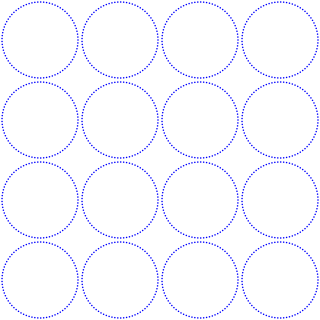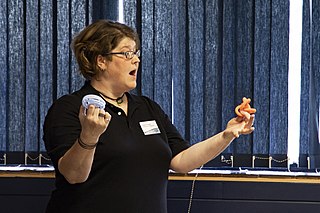
In the mathematical field of graph theory, a Hamiltonian path is a path in an undirected or directed graph that visits each vertex exactly once. A Hamiltonian cycle is a cycle that visits each vertex exactly once. A Hamiltonian path that starts and ends at adjacent vertices can be completed by adding one more edge to form a Hamiltonian cycle, and removing any edge from a Hamiltonian cycle produces a Hamiltonian path. The computational problems of determining whether such paths and cycles exist in graphs are NP-complete; see Hamiltonian path problem for details.

Arthur Cayley was a prolific British mathematician who worked mostly on algebra. He helped found the modern British school of pure mathematics.
In mathematics, the isoperimetric inequality is a geometric inequality involving the perimeter of a set and its volume. In -dimensional space the inequality lower bounds the surface area or perimeter of a set by its volume ,
In the mathematical field of graph theory, a vertex-transitive graph is a graph G in which, given any two vertices v1 and v2 of G, there is some automorphism

Béla Bollobás FRS is a Hungarian-born British mathematician who has worked in various areas of mathematics, including functional analysis, combinatorics, graph theory, and percolation. He was strongly influenced by Paul Erdős since the age of 14.

Pseudomathematics, or mathematical crankery, is a mathematics-like activity that does not adhere to the framework of rigor of formal mathematical practice. Common areas of pseudomathematics are solutions of problems proved to be unsolvable or recognized as extremely hard by experts, as well as attempts to apply mathematics to non-quantifiable areas. A person engaging in pseudomathematics is called a pseudomathematician or a pseudomath. Pseudomathematics has equivalents in other scientific fields, and may overlap with other topics characterized as pseudoscience.

Sudoku is a logic-based, combinatorial number-placement puzzle. In classic Sudoku, the objective is to fill a 9 × 9 grid with digits so that each column, each row, and each of the nine 3 × 3 subgrids that compose the grid contains all of the digits from 1 to 9. The puzzle setter provides a partially completed grid, which for a well-posed puzzle has a single solution.

Robin James Wilson is an English mathematician. He is an emeritus professor in the Department of Mathematics at the Open University, having previously been Head of the Pure Mathematics Department and Dean of the Faculty. He was a stipendiary lecturer at Pembroke College, Oxford and, as of 2006, Gresham Professor of Geometry at Gresham College, London, where he has also been a visiting professor. On occasion, he teaches at Colorado College in the United States. He is also a long standing fellow of Keble College, Oxford.

Mathematics can be used to study Sudoku puzzles to answer questions such as "How many filled Sudoku grids are there?", "What is the minimal number of clues in a valid puzzle?" and "In what ways can Sudoku grids be symmetric?" through the use of combinatorics and group theory.

In graph theory, a rook's graph is an undirected graph that represents all legal moves of the rook chess piece on a chessboard. Each vertex of a rook's graph represents a square on a chessboard, and there is an edge between any two squares sharing a row (rank) or column (file), the squares that a rook can move between. These graphs can be constructed for chessboards of any rectangular shape. Although rook's graphs have only minor significance in chess lore, they are more important in the abstract mathematics of graphs through their alternative constructions: rook's graphs are the Cartesian product of two complete graphs, and are the line graphs of complete bipartite graphs. The square rook's graphs constitute the two-dimensional Hamming graphs.
Edward Granville Sewell is an American mathematician, university professor, and intelligent design advocate. He is a professor of mathematics at the University of Texas, El Paso.

Maki Kaji was a Japanese businessman who was the president of Nikoli, a puzzle manufacturer. He is widely known as "the father of Sudoku" for his role in popularizing the number game.

In the mathematical field of graph theory, the Brouwer–Haemers graph is a 20-regular undirected graph with 81 vertices and 810 edges. It is a strongly regular graph, a distance-transitive graph, and a Ramanujan graph. Although its construction is folklore, it was named after Andries Brouwer and Willem H. Haemers, who proved its uniqueness as a strongly regular graph.
Godless: How an Evangelical Preacher Became One of America's Leading Atheists is a book which was written by Dan Barker in 2008, in which he describes his deconversion from being a preacher to becoming an atheist.

Colm Mulcahy is an Irish mathematician, academic, columnist, book author, public outreach speaker, and amateur magician. He is Professor Emeritus at Spelman College, where he was on the faculty from 1988 to 2020. In addition to algebra, number theory, and geometry, his interests include mathemagical card magic and the culture of mathematics–particularly the contributions of Irish mathematicians and also the works of iconic mathematics writer Martin Gardner. He has blogged for the Mathematical Association of America, The Huffington Post, Scientific American, and (aperiodically) for The Aperiodical; his puzzles have been featured in The New York Times. Mulcahy serves on the Advisory Council of the Museum of Mathematics in New York City. As of January 2021, he is Chair of Gathering 4 Gardner, Inc. He is the creator and curator of the Annals of Irish Mathematics and Mathematicians.
In graph theory, precoloring extension is the problem of extending a graph coloring of a subset of the vertices of a graph, with a given set of colors, to a coloring of the whole graph that does not assign the same color to any two adjacent vertices.

Laura Anne Taalman, also known as mathgrrl, is an American mathematician known for her work on the mathematics of Sudoku and for her mathematical 3D printing models. Her mathematical research concerns knot theory and singular algebraic geometry; she is a professor of mathematics at James Madison University.

In the mathematics of Sudoku, the Sudoku graph is an undirected graph whose vertices represent the cells of a (blank) Sudoku puzzle and whose edges represent pairs of cells that belong to the same row, column, or block of the puzzle. The problem of solving a Sudoku puzzle can be represented as precoloring extension on this graph. It is an integral Cayley graph.

Taking Sudoku Seriously: The math behind the world's most popular pencil puzzle is a book on the mathematics of Sudoku. It was written by Jason Rosenhouse and Laura Taalman, and published in 2011 by the Oxford University Press. The Basic Library List Committee of the Mathematical Association of America has suggested its inclusion in undergraduate mathematics libraries. It was the 2012 winner of the PROSE Awards in the popular science and popular mathematics category.

William Asbury WilliamsD.D. was an American Presbyterian clergyman and creationist writer.














